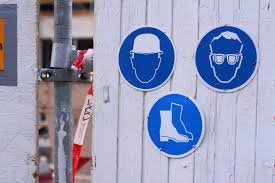Articles
Your one stop shop for all your health and safety resources
Green Means Go – Understanding the true Psychology of Safety Signs

Think of the last time you were driving a vehicle in a busy underground parking lot: the directional arrow paintings on the tarmac; the lit exit signs above head leading to the way out or next level of parking; the one-way messages or the emergency exit door signs.
It is a common discussion amongst many of our colleagues when they mention their weekend visit to the new shopping centre or mall that has just opened in town. Parking arrangements in such locations normally come up and, in many cases, signage and the ease of access and egress can significantly define a visitors’ experience.
Signage, whether related to health and safety or not, can ensure individuals unfamiliar to an area can immediately gain a better sense of their surroundings, a familiarity which can ultimately play a significant role in their overall health and wellbeing. Signs can be used for a variety of purposes, but in essence, they are there to communicate a message, whatever that message may be.

When it comes to the safety of individuals, effective safety or emergency warning signs can be utilised to influence people’s behaviours in a certain way.
In a workplace, safety signs can help lessen the likelihood of accidents. Particularly in a work environment where people from all walks of life converge. Besides that, having safety signs complies with various health and safety regulations worldwide. They are meant to protect employees, contractors, or visitors in crucial locations within the business.
Health and safety signs for example, can provide different approaches to how hazards are communicated.
These can be Persuasive in nature, warning individuals of the risk of coming into contact with a particular hazard such as warning that a high electrical voltage can present a significant risk of electrocution.
They may also have a more Informative approach where employees are informed of times operations may need to be halted as a result of a change in weather conditions or as a result of other simultaneous activities in the area.

Directional signs in many countries are legal requirements specifically when it comes to highlighting the location of emergency exits or muster points. Such signs are utilised to create a more familiar environment for individuals within a work location and ensure they are steered away from hazardous areas and are aware of where to go in the event of an emergency.
Similarly, Warning signs, also a legal requirement in most countries worldwide, ensure that the public are informed and warned about potential hazards. Various international regulations have set out standards about when and where warnings are necessary. They may often be required to display certain colours or be reflective in nature to increase their visibility. Traffic warning signs can be the best examples of such signs.
Use of Color in Safety Signage
Numerous country regulations recommend standard use of colors when it comes to health and safety signs. Individuals would need to review such regulations before designing warning type signs for their respective businesses. Before we delve into the colors, we must first understand coding in relation to the warning language that marks hazards in a given workplace:
- Danger: Red and predominantly red colours are mostly used to warn of danger. These colours are used to advertise and warn of a potential hazard. Danger symbols and letterings apply contrasting colours against a background. This will give the signage a bold maximum visibility that can be noticed from a distance.
- Warning: This signage and its respective colours are meant to highlight a potential risk. It is not as immediate as the danger sign, but it still communicates a significant hazard. This sign mostly uses predominantly orange or orange with a contrasting background to make it visible from afar.
- Caution: These types of signs announce a potential risk that might cause harm either to an object or a person. Depending on the country, these signs will mostly use predominantly yellow to just yellow with other contrasting colours to clearly communicate from a distance.
- Biological Hazard: These safety signs have their own unique categories. This is because of the unique risk they are publicising. Most biohazards will use varying unique colours. However, some will make use of the common fluorescent orange or orange-red.
Many colours can be commonly found in different types of safety and emergency signs. For example, Red is perfect for fire hazards. If there is a fire break out in a given area, using red colours on safety signage is the best way to communicate such hazards. Red can is also commonly used near flammable materials that present a risk of explosion.
Yellow, on the other hand is mostly used to warn of potential hazards such as falling, slipping or tripping. They can also be used to indicate strikes and pinch points. Yellow is commonly utilised in industrial areas and warehouses. It is a loud colour that would be hard to escape inattentive eyes.
Orange mostly warns about dangerous machinery and equipment in a given workplace and can communicate hazards such as crushing or being struck by objects.
Green will mostly indicate safety exits in a building. It marks the exit routes and indicates emergency muster point areas. Green is also commonly used to mark the first aid stations and some safety equipment.

Ways to Improve Safety Signage in the Workplace
They mostly come off as trivial, but there are many cases of health and safety signage being used in ways that can significantly support an organisation’s health and safety culture. In addition to the basic emergency and warning signage we discussed earlier, many organisations effectively use safety signage to remind their employees of key hazards within the workplace. Cleverley thought-out signs can act as strong reminders to what employees may have already learnt in their health and safety inductions or general safety programmes.
The following are a number of points to consider when assessing the effectiveness of health and safety signage within a business:
1. They must communicate the risks effectively
Safety signage can use different codes to communicate to the public. This includes colour-coding and texts. The sign size and the placement of the post are also important especially because they should visibly and loudly communicate key messages.
Since literacy and language barriers can vary from site to site, it is important to use signs that can be understood by all. Whether an employee is a Chinese or an English speaker, they should be able to read and understand most, if not all, safety signage using the colour coding and the symbols used on the signs. If texts are to be used in such cases, they should be in languages commonly understood by persons within that workplace.
2. Location of the safety signage
Safety signage should be appropriately positioned for all to see. For example, signs on hazardous or dangerous machinery should be made clear. The same goes for slippery or dangerous places that need specific personnel protective equipment (PPE) before entering.
A sign should be close enough to the hazardous equipment to ensure employees, contractors or the general public are able to keep a safe distance. It should also be in a strategic location like the exit or the entrance to a facility. This will help people avoid danger zones and ensure they are well aware that they are in a hazardous work environment.
3. Don’t mix signs
The idea is to create order and inform. Not to confuse and misdirect the public. The best organisations tend to control the health and safety signs used within their workplaces, they ensure it is in line with their overall corporate communications and follows a uniform standard. Effective health and safety communications require proper coordination, and where possible, corporate communication to work hand in hand with health and safety professionals in order to determine the language and the approach to safety signage the organisation requires.
The signs should also be consistent with what is going on at a shop floor level. While it is easy to go overboard trying to effectively communicate workplace risks, it is good to think about the purpose and the information being conveyed. The safety signage should be relevant, timely, and actionable.
4. Ensure they follow relevant country standards
When working with safety signage, it is essential to consider country regulations or overall standards applied within the workplace. In Europe for example, the regulations have harmonised signs across the European Union so that signs across the member states will have the same meaning in whichever country they are used in. These are highlighted under the BS EN ISO 7010 standard and currently include the United Kingdom despite the recent Brexit.
In the United States, OSHA also specifies the colours that are required to be used to signal workplace hazards with the ANSI/NEMA Z535 series composed of a number of documents that provide details on safety colours, facility and safety sign requirements, criteria for safety symbols and many more.
5. Make them personnel
More and more organisations are looking at new approaches to achieve safe and healthy workplaces. As a result, they apply the learnings from the many years of analyses of accidents and ill health, as these will contribute to future prevention strategies and activities.
Safety signs can be used as a means to enforce positive safe behaviours within the workplace when they provide subtle messages as to the impact of a potential injury.
While it is easy to place safety signage in a work environment or public setting, it is easy to forget that not everybody will have the luxury of understanding these signs. Issues such as language barriers, illiteracy, and blindness are always going to be key considerations. It is always key to remember that in addition to having a good system for safety signs across the workplace, there is still a need for educating the public and making the signs friendly to the visually impaired. Building a safe place for all will nearly always require a certain out-of-the-box type of thinking approach. This, on many occasions, can mean going above and beyond health and safety authority recommendations and ensuring that security for every individual in your workplace is catered for.

Submit form
+ Training
+ Consulting
+ Support Services
+ Professional Development
Let us know which service you are interested in:
Please complete the form below and a member of our team will be in touch within 1-3 business days
Thank you for your interest in Demoura Lawson Consulting
Contact Us
Qatar: Unit Office No. 1905: 19th Floor, The E18hteen Tower , Bldg 230, Street 303, Zone 69, Lusail Marina , Qatar
Tel: +974 4445 9206
Saudi Arabia: 3121 Imam Abdullah Bin Saud Bin Abdulaziz Road, Ishbiliyah, Riyadh 13225, Saudi Arabia
Tel: +966 50 685 6910
ADD A COMMENT